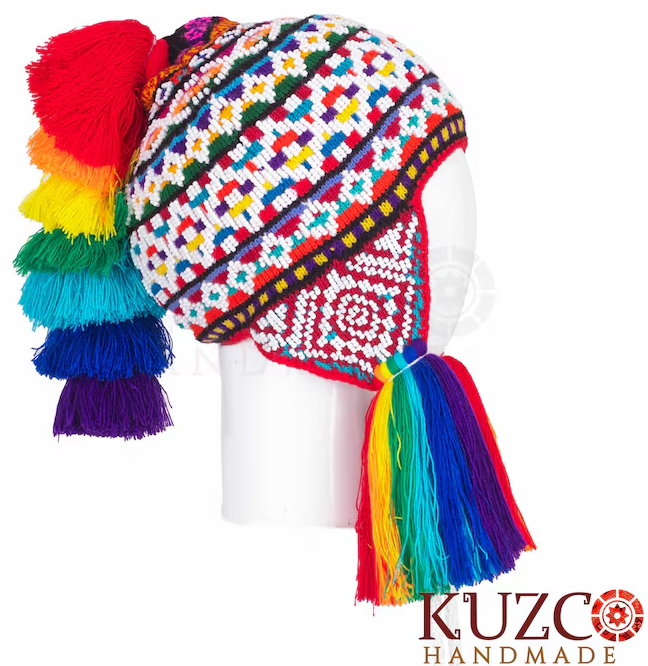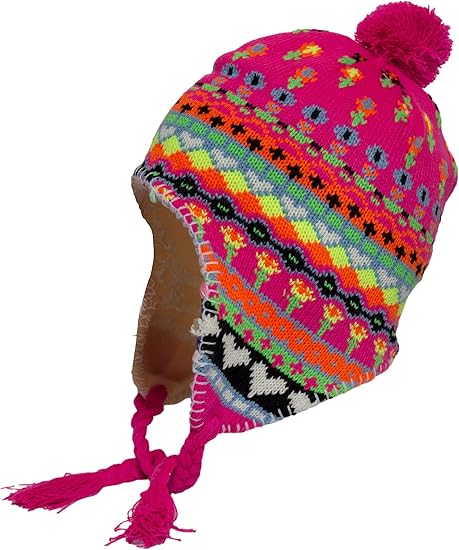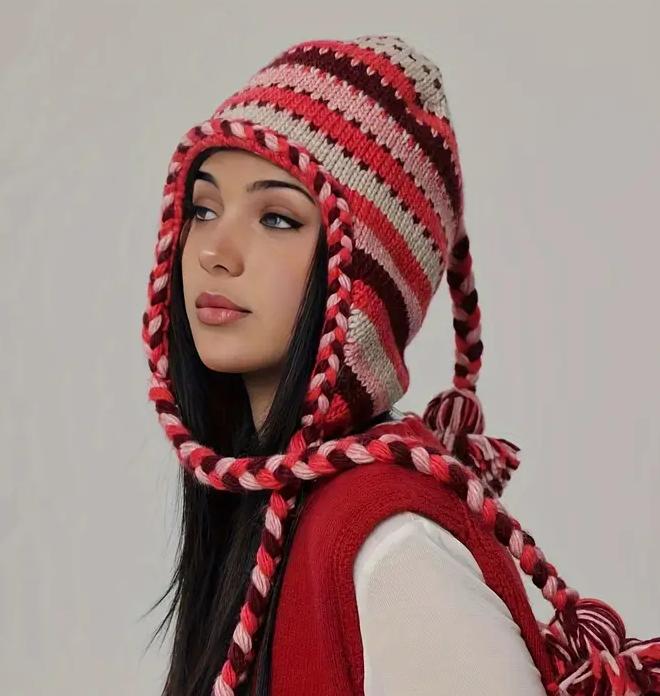Index:
Imagine walking through the heights of Cusco, the icy wind brushing your skin, and seeing locals with knitted hats bursting with color. That’s the Peruvian chullo: a garment that warms both body and soul, steeped in tradition. Join me on this journey to explore its history, cultural magic, and how to get one that speaks of the Andes.
Who can wear a Peruvian chullo and how to choose the best one?
The Peruvian chullo is for anyone who wants to carry a piece of Peru with them. It’s perfect for travelers trekking through icy mountains, lovers of handmade crafts seeking unique pieces, or simply someone who wants a hat with personality. Men, women, and children wear it, from adventurers climbing Machu Picchu to those strolling through cold cities in search of style. Its advantages? It’s warm, lightweight, and so beautiful it feels like a woven painting.
To choose a good one, look at the wool: alpaca is as soft as a caress and warms without weighing you down, while llama wool is stronger, ideal for extreme cold. Seek a hand-knitted Peruvian chullo with designs that shout Andean tradition: geometric lines, animals, or colors that tell stories. Make sure the earflaps cover well and the size fits comfortably. An authentic chullo not only protects you from the cold but connects you to the heart of the Andes.
Where to buy a Peruvian chullo?
If you want a Peruvian chullo, there are options for every taste. Etsy.com is a haven for handmade items: there you’ll find chullos crafted by Peruvian weavers, each with its unique soul. Amazon is ideal if you prefer a quick purchase, with variety and excellent service. And if you’re looking for something more budget-friendly, Temu offers chullos at good prices, though check the quality carefully. Here’s a space for your table with three options that will surely delight your readers:
What is the Peruvian chullo?
The Peruvian chullo is a woolen hat with earflaps, born in the heights of the Andes. It’s not just clothing: it’s a piece of history dating back to pre-Inca times, when ancient peoples knitted to survive the mountain cold. It’s used in Peru, Bolivia, Ecuador, and Chile, but in the Peruvian heart, especially in Cusco or Puno, it shines. Each chullo is a canvas: its designs reflect the life of the weaver, from the llamas grazing in the puna to the symbols of their communities.
Why is the Peruvian chullo so colorful?
If you’ve ever seen a chullo, you know its colors are a carnival in wool. Why so vibrant? Because each shade tells something. Red might be the blood of ancestors, green the generous Pachamama, yellow the sun illuminating the heights. Geometric patterns or figures like alpacas and mountains aren’t just decoration: sometimes they show the wearer’s origin or status. Knitting a chullo is like painting with threads, and the result is an explosion of life that brightens even the grayest day.
In which regions of Peru is the chullo widely used?
The chullo is king in Peru’s highlands, where the cold bites. In Cusco, you see it in markets and festivals, proudly covering heads. In Puno, near Lake Titicaca, it’s an inseparable companion against the icy wind. Arequipa and Huancavelica also embrace it, because at over 3,000 meters, the weather is unforgiving. There, men knitting in the square or children running with colorful chullos are snapshots of daily life.
What wool is a typical Peruvian chullo made of?
A true Peruvian chullo carries the soul of Andean animals. Alpaca wool is the star: soft as a cloud, light, and so warm it feels like magic. Llama wool is more rustic, resilient, perfect for harsh days. Sometimes sheep wool is used, but artisans prefer the local, what comes from Peruvian soil. Imagine the smell of freshly sheared wool, the silky touch between your fingers: that’s what makes a chullo special.
What does the word “chullo” mean in Quechua?
“Chullo” comes from the Quechua “ch’ullu,” meaning “hat with earflaps.” Quechua, the language of the Incas, still lives in the Andes, and this word is a mountain heritage. When you say it, you can almost feel the echo of the heights, the whisper of grandmothers knitting by the fire. It’s a simple name, but laden with centuries of culture.
What is the Peruvian winter hat called?
The Peruvian winter hat is undoubtedly the chullo. Though in some corners it’s called “chuyo” or “Andean hat,” “chullo” is the name that resonates most strongly. It’s like the king of hats: practical, beautiful, and with a past that makes it unforgettable.
How do you spell the word “chullo” or “chuyo”?
Here’s a little Andean debate: “chullo” is the most common form, the one you see in books and markets. But “chuyo” also appears, especially in rural areas. Both are correct, though “chullo” wears the crown in modern Peru. Either way, what matters is what it represents: tradition woven with love.
A journey to the past: the history of the chullo
The chullo isn’t new to this world. Before the Incas built their roads, ancient peoples already knitted hats for the cold. With the Inca empire, they became finer: nobles wore them with designs that shouted power, while farmers made them simple but strong. When the Spanish arrived, the chullo didn’t surrender; it stayed in the heights, quietly being knitted. Today, it’s a bridge between past and present, a living relic that Peruvian artisans care for with pride.
My encounter with a chullo in Cusco
I’ll never forget my first chullo. It was a freezing day in Cusco, the sky gray as stone, and I was shivering in the Plaza de Armas. An elderly man, with weathered hands, showed me one: “Look, I made it with alpaca wool from my herd.” It had llamas knitted in red and white, and when I put it on, the cold vanished. He told me his grandmother taught him to knit, and I felt I wasn’t just buying a hat, but a story. Since then, every time I wear it, I smell the wool and see those cobblestone streets.
The art behind a chullo
Knitting a chullo is like writing a song with needles. Andean women, sitting in circles, turn wool into art. First, they dye the threads with plants and minerals: cochineal for red, molle for green. Then, with patience, they knit each line, each figure. A good chullo can take days, and when you finish, you feel the weight of tradition in your hands. It’s a craft passed from mothers to daughters, a legacy that doesn’t fade.
A hug for the senses
Touch a chullo and you’ll understand why it’s special. Alpaca wool is so soft it feels like velvet, yet it warms like a lit hearth. The colors—reds, blues, yellows—dance like a festival in your eyes. Put it on, and the earflaps envelop you, silencing the wind whistling through the mountains. It smells of pure wool, of damp earth, of the pastures where alpacas roam. It’s a piece of the Andes you can carry with you.
The chullo as cultural soul
In the Andes, the chullo is more than clothing: it’s identity. At festivals in Puno or fairs in Huancavelica, you see it shining on every head, telling who they are and where they come from. The designs speak: a llama might mean abundance, a zigzag the path of life. Knitting it brings people together; women chat, laugh, and share secrets while their hands shape the wool. It’s a living symbol, a cry of Peruvian pride.
A comparison that will make you smile
Put on a chullo and you’ll feel the Andes giving you a hug. It’s like sipping hot chocolate on a cold night or hearing a quena that gives you goosebumps. Each thread is a note in the melody of Peruvian culture, and wearing it is like walking with a piece of history on your head.
A touch of Andean laughter
What if I tell you the chullo is the superhero of hats? Picture yourself in New York, with your red and green chullo, and everyone looking at you like you’re a modern Inca. “What’s that?” they ask. “My secret weapon against the cold, and it gives me Andean style too!” It’s practical, beautiful, and a little magical, don’t you think?
Until next time, dear chullo
The Peruvian chullo is a treasure woven with love, history, and colors that sing. Whether you wear it for the cold or to show off, it will always carry the essence of the Andes. I hope these words have taken you to the Peruvian heights and inspired you to seek your own chullo. Can you already imagine yourself with one, feeling its warmth and its story?




